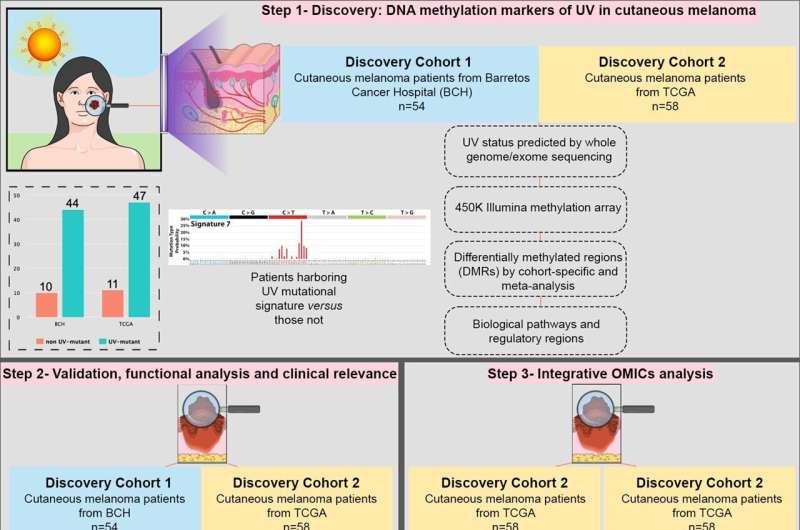Study maps alterations that make melanoma more severe, could lead to better therapies and diagnosis

A group of researchers based in Brazil and France have managed to discover markers left by exposure to sunlight in the genomes of people who suffer from cutaneous melanoma. An article about the study published in Nature Communications also offers a novel understanding of other melanomas not caused by the effects of ultraviolet (UV) radiation.
"We found some of the alterations to be markers of the patient's survival. We were able to predict whether a person was more or less likely to survive thanks to these markers present in their DNA," said Anna Luiza Silva Almeida Vicente, first author of the article.
Vicente performed part of the analysis during a research internship at the International Agency for Research on Cancer (IARC) in Lyon, France.
The study, in which researchers affiliated with IARC took part, revealed the molecular characteristics that may indicate aggressiveness and guide treatment.
One of the melanomas analyzed was cutaneous melanoma, which has one subtype associated with solar radiation and another with no relation to UV light. These tumors occur above all in white people and mainly affect parts of the skin exposed to sunlight.
A small proportion of the samples came from acral melanoma, which has no association with UV light, is the most common type in people with darker skin, and forms on the palms and soles and under nails. Little research has been done on acral melanoma. Most studies focus on the populations of Europe and the US.
"There are several melanoma subtypes. They can all be aggressive, but aggressiveness is more common in some. There are histological characteristics, which are identified under a microscope, and genetic traits, some of which are known and used to guide treatment. We're opening up a new route in this area, which is epigenetic and takes into account the presence of exposure to sunlight resulting in alterations not to the DNA sequence [i.e. genetic mutations], but to how it's expressed and encodes proteins that are important to normal functioning of the organism," said Vinicius de Lima Vazquez, Executive Director of Hospital de Amor's Institute of Education and Research and penultimate author of the article.
Molecular information
Epigenetic changes are due to environmental factors. They are reversible and do not change the DNA sequence to cause mutations, but they can change how the body reads it and they may be heritable.
In the study, the researchers used several techniques to analyze DNA methylation, an epigenetic alteration that involves a biochemical change in which the action of enzymes adds methyl groups to the DNA molecule.
DNA methylation is a necessary process but can cause cellular dysfunction and lead to cancer if it is dysregulated owing to external factors, such as excessive exposure to UV light.
The researchers analyzed 112 cutaneous melanoma samples and 21 acral melanoma samples. The former were collected from Hospital de Amor and an international database mainly representing European and US patients. All acral melanoma samples came from the Barretos hospital.
Analysis of methylated DNA showed cutaneous melanomas not associated with exposure to sunlight to be much more similar to acral melanomas (which are not influenced by UV radiation and are more common in people with dark skin) than to cutaneous melanomas associated with excessive exposure to UV light.
These findings were corroborated by survival rates, which were lower for patients with acral and cutaneous melanomas not associated with exposure to sunlight than patients with cutaneous melanomas associated with exposure to UV light.
"We concluded that these two tumors not associated with exposure to sunlight could be histologically classified as different subtypes but were molecularly very similar from the methylation standpoint, and also had lower survival rates. This is an important part of the study and could have a clinical impact in future," said Vicente, who is currently doing postdoctoral research at the University of California, San Francisco (UCSF) in the US.
Another finding that drew the researchers' attention was that mutations in the genes BRAF, NRAS and NF1 were not observed in most of the acral melanomas although they are frequent in cutaneous melanomas.
Moreover, 28.6% of the acral melanoma patients were Black, whereas only 5.6% of the cutaneous melanoma samples from Hospital de Amor were from patients with dark skin.
According to Vazquez, some treatments for other types of cancer are advancing toward associating molecular information with prognosis and identifying patients who respond better to the available therapies. This is one of the aims of studies of skin tumors.
"More information of this kind about melanomas is needed for use in day-to-day medicine. Studies like this point to novel lines of investigation to be explored and pave the way for more personalized treatment," he said.
More information: Anna Luiza Silva Almeida Vicente et al, Cutaneous and acral melanoma cross-OMICs reveals prognostic cancer drivers associated with pathobiology and ultraviolet exposure, Nature Communications (2022). DOI: 10.1038/s41467-022-31488-w




















